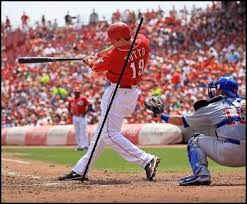Now that the stance is complete and the hitter is comfortable it is time to work on the swing. The swing is going to be consistent for every hitter. No matter what your stance is or where your feet are, the mechanics for the swing will be the same.
-
Load
The load is the part of the swing where the weight shifts from being balances to about 60 percent on the back leg and 40 percent on the front leg. The hitter does not want to have too much weigh on one leg because he still needs to be able to move and have good balance. The hitter will usually take some sort of small step during the load as well. This step will be toward the pitcher still. The hands of the hitter can either stay still, or they can shift slightly back toward the catcher/umpire. The hands do not want to rotate back behind the hitter. This is called wrapping and will make the hitter’s swing to long.
-
Hips
 The hips are the first thing that will move toward the pitch. The hips will pivot around the center axis that should split your body in half. Your front leg should maintain stiff causing torque to build up. This is where the power in the swing is generated. Your back foot will twist. This twisting action is sometimes called squashing the bug. It is called that because it looks like the hitter is squashing a bug with their back foot. This type of learning style would be called elaboration. This hitter will remember squashing the bug and reference that more often.
The hips are the first thing that will move toward the pitch. The hips will pivot around the center axis that should split your body in half. Your front leg should maintain stiff causing torque to build up. This is where the power in the swing is generated. Your back foot will twist. This twisting action is sometimes called squashing the bug. It is called that because it looks like the hitter is squashing a bug with their back foot. This type of learning style would be called elaboration. This hitter will remember squashing the bug and reference that more often. -
Hands
 The hands will follow the hips through the strike zone. The hands should be on the same plan as the baseball is coming into the zone. The longer the hitter can keep his hands in the zone, the greater chance the hitter has to making contact with the ball. Make sure to keep your hands in tight while you are swinging. The hitter does not want to have his hands go to far away from his body. This is called casting. Casting will cause your swing to be slower which will result in not being able to hit the ball squarely off the bat.
The hands will follow the hips through the strike zone. The hands should be on the same plan as the baseball is coming into the zone. The longer the hitter can keep his hands in the zone, the greater chance the hitter has to making contact with the ball. Make sure to keep your hands in tight while you are swinging. The hitter does not want to have his hands go to far away from his body. This is called casting. Casting will cause your swing to be slower which will result in not being able to hit the ball squarely off the bat.A way to prevent casting is to stand next to a fence. Put your bat between you and the fence lengthwise so you can let go of the bat and it still stays there. Now without moving, take the bat and swing. This will help keep your hands in tightly. If you do not, the bat will hit the fence.
-
Head
The head for the hitter should be tracking the pitch the whole time it is coming in. Try and keep the head up-right so it is easier to track. Having the hitter’s eyes horizontal will make it easier for them to be able to track the ball and see the movement of the pitch.
Once the pitch comes in, the head should rotate on the same axis that the hips did. Even if the hitter does not swing at the pitch, they should track the ball all the way into the catcher’s mitt. This will assure that they watched the ball all the way through the zone. If the hitter swings at the pitch, they should still watch the ball all the way until they make contact with the ball.
